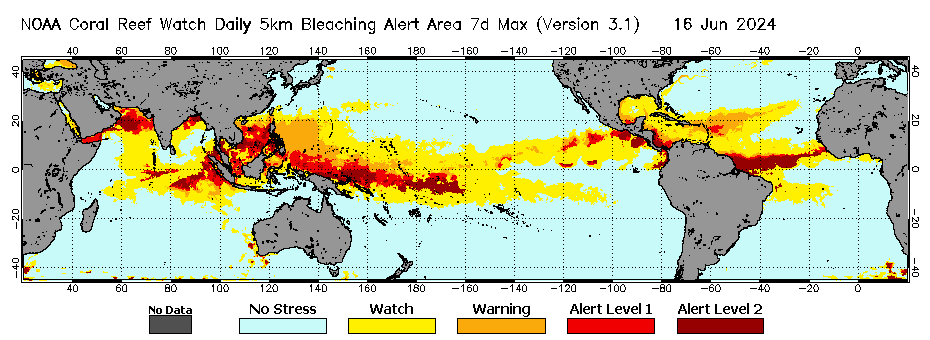(Version 3.1, released August 1, 2018)
(Click here to view these images in a new, enhanced style)

| Current Daily Variables: | Alert Area (7-day max) |
|
|
|
|
|
|
|
|
|
| Year-to-date Maximum: | ----- | |||||
| Year-to-date Minimum: | ----- | ----- | ----- | ----- | ||
| Year-to-date Mean: | ----- | ----- | ----- | ----- |
Click on map above to zoom to small 60 x 40-degree tiles; use drop-down menu below to view larger 60 x 40-degree tiles.
Right-click outside clickable map area to save the image.
|
The NOAA Coral Reef Watch (CRW) daily global 5km satellite Bleaching
Alert Area (7-day maximum) product presented here outlines the areas where coral bleaching heat
stress currently reaches various levels, based on our
satellite sea surface temperature (SST) monitoring.
|
|
Stress Level
|
Definition
|
|
||
|
|
|
|
|
Note that in the Bleaching Alert Area (7-Day Maximum) composite product, locations with a status of No Stress
or Bleaching Watch, for a 7-day time period, may still have been exposed to recent heat stress,
including in the days immediately preceding the 7-day period under evaluation. The reason is that
the Bleaching Alert Area (7-Day Maximum) composite product classifies the heat stress condition for a specified 7-day period
only -- and that heat stress condition (level) is determined by the seven, most-recent daily value pairs of CRW's v3.1 daily global
5km Coral Bleaching HotSpot and DHW.
So if, during the specified 7-day period being evaluated, the seven Coral Bleaching HotSpot values (within the seven daily pairs
of Coral Bleaching HotSpot/DHW) were all zero, this would indicate the absence of active heat stress.
For that reason, a No Stress level would be assigned, and any heat stress experienced during the 11 weeks preceding the 7-day period
would not be examined, as corals should be in a recovery state. If, during the specified 7-day period being evaluated, any of the
seven Coral Bleaching HotSpot values (within the seven daily Coral Bleaching HotSpot/DHW pairs) was greater than zero,
but below the bleaching threshold for accumulating DHWs, this would indicate that there is currently insufficient heat stress
to actively cause or worsen visible bleaching. For this reason, none of the seven daily DHW values (within the seven daily Coral Bleaching
HotSpot/DHW pairs) would be examined; a Bleaching Watch level would be assigned; and any recently-accumulated DHWs greater than zero,
that occurred within the 11 weeks preceding the 7-day period, would not be used to determine the current heat stress level.
With that said, if on any future day, the Coral Bleaching HotSpots resurrected, and were greater than the threshold for accumulating
DHWs, then recent heat stress exposure during the entire past 12 weeks (84 days) would be evaluated. This means all daily
Coral Bleaching HotSpot values that exceeded the bleaching threshold during the past 12 weeks would be accumulated to calculate the DHWs
and determine the Bleaching Alert Area (7-Day Maximum) composite product heat stress level. As a result, a future heat stress level
could jump from No Stress or Bleaching Watch to any of the higher stress levels, as the calculation would again be dependent on
recent heat stress exposure during the entire last 12 weeks. Please refer to CRW's
daily global 5km DHW product for more information.
|